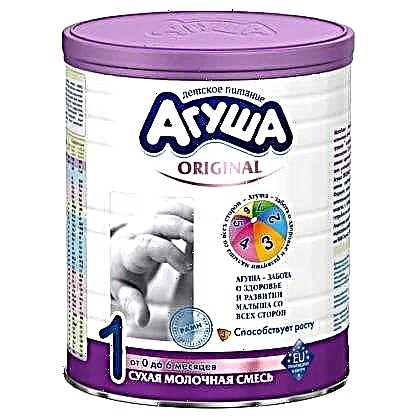A lot of work has been done to convey knowledge about the benefits of breastfeeding. These are reference books, textbooks, and articles on the Internet. The Ministry of Health actively promotes natural feeding and provides support to young parents. This is manifested in maternity hospitals and further in children's clinics in the form of educational posters, stands, in the friendly and eager to train staff of medical institutions. Mixture "Agusha" and similar ones are produced specially for additional feeding. And this is no coincidence. Indeed, in the modern world, full of a negative state of the environment, an unhealthy lifestyle of the future parents themselves and their unhealthy diet, breastfeeding is considered as the best, most suitable nutritional option for babies. But what to do if a young mother, for one reason or another, cannot provide breastfeeding? The answer is obvious - choose a mixture, for example, from Agusha.
Mixtures - milk replacers
In situations where a child cannot receive breast milk, doctors recommend switching to formula - artificial feeding. Depending on the volume of the mixture eaten per day, artificial feeding is divided into full and partial.
 The younger the child, the closer the selected formula should be to the composition of breast milk. Depending on the composition, the mixtures are divided into partially adapted and highly adapted. This indicates a partial and complete closeness to the composition of breast milk.
The younger the child, the closer the selected formula should be to the composition of breast milk. Depending on the composition, the mixtures are divided into partially adapted and highly adapted. This indicates a partial and complete closeness to the composition of breast milk.
Today there are a huge number of types of formula for baby food. What is the right and safest way to find the right formula for your baby? Parents should approach this issue very responsibly and together with a pediatrician. After all, the baby's nutrition, especially in the first year of life, predetermines the child's metabolism in the future and, accordingly, in this way, the development of certain diseases that arise in adulthood can be prevented.
Agusha mixture in baby food
Guided by clinical research, work experience and parental feedback, many pediatricians recommend Agusha products. These products have been used as baby food for over 30 years, expanding the list of products from year to year and improving the design and packaging, making it easy to use both at home and outdoors.
 All formulas are as close as possible in their composition to the composition of breast milk. They contain proteins that serve as building blocks and tools for the immune system. Nucleotides (structural units of protein) contribute to the formation of immunity, stimulate the growth and development of enterocytes.
All formulas are as close as possible in their composition to the composition of breast milk. They contain proteins that serve as building blocks and tools for the immune system. Nucleotides (structural units of protein) contribute to the formation of immunity, stimulate the growth and development of enterocytes.
Vitamins and minerals, bifidobacteria and lactobacilli, which are part of the Agusha mixture, are also directly involved in the development of immunity. The amino acid taurine is essential for the development of the central nervous system and the retina. Fats in the form of sunflower, palm, coconut and rapeseed oils are important components of cell membranes and are also necessary for the formation of myelin in nerve fibers.
The optimal ratio of all components improves their digestibility, normalizes metabolism, and improves the baby's appetite.
"Agusha" offers young parents a mixture of several types.
By consistency, there are two types of mixtures:
- Liquid (ready-to-eat): fresh and fermented milk.
- Dry: fermented milk.
By age category:
- 0 - 6 months (Agusha-1 3.4%, Agusha-1 fermented milk 3.5%, Agusha-1 Gold);
- 6 - 12 months (Agusha-2 3.1%, Agusha-2 fermented milk 3.4%, Agusha-2 Gold).
Unfortunately, the production and production of dry mixes is currently suspended.
 All mixtures are maximally adapted. Among themselves, the types of mixtures differ only in the presence of prebiotics in the form of oligosaccharides and probiotics in the form of bifidobacteria in the fermented milk mixtures, the presence of the amino acid taurine in Agusha Gold.
All mixtures are maximally adapted. Among themselves, the types of mixtures differ only in the presence of prebiotics in the form of oligosaccharides and probiotics in the form of bifidobacteria in the fermented milk mixtures, the presence of the amino acid taurine in Agusha Gold.
Fermented milk mixtures are recommended for children with functional digestive disorders in the form of constipation, colic, flatulence, and for babies with food allergies.
It should be noted that fermented milk mixtures are recommended not only for the treatment of the conditions described above, but also for prevention. Especially if at least one of the parents has an allergic disease.
How to give Agusha mixture?
Starting to introduce the above mixtures into the diet, it is necessary to adhere to the general principles of using the new product. On the first day we give 10 ml, on the second day 20 ml. By the end of the first week, we bring the volume of the mixture to 50 - 60 ml, which may well replace one feeding.
When introducing a new product, be sure to look at the child's reaction, to the skin, paying attention to folds, stools.
Already in the second half of a child's life, one mixture is not enough. It is also necessary to start introducing complementary foods together with a pediatrician, taking into account the weight of the child, the nature of his chair. If the baby ate the Agusha mixture, then it is advisable to continue to introduce complementary foods of the same brand in the future.
"Agusha" offers a huge list of products for the first complementary feeding - puree, cereals, and juices. Further, for nutrition, the line contains a variety of fermented milk products - kefir, fermented baked milk, cottage cheese.
When choosing milk supplements for your baby, pay attention to the expiration dates, the state of the packaging. Remember, these dairy products cannot be stored open even if refrigerated.
Agusha, together with pediatricians, takes care of the health of our children. The task of parents is to heed the advice of experts and make the right choice.
Article rating:



